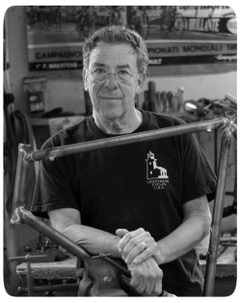Tim Neenan

TIM NEENAN
By now we all know that Mike Sinyard introduced the first widely accepted mass produced mountain bike, the ‘Stumpjumper’. But the man who actually conceived the bike, built the first prototype and convinced Sinyard to put it into production, was someone else entirely, a nearby framebuilder from Santa Cruz.
Tim Neenan’s Lighthouse frames were well known on the central coast of California when Mike Sinyard approached Tim in 1980 about the possibility of designing a small line of road bikes for Specialized, frames that would offer the quality, details and range of sizes then offered only by small builders. This conversation gave birth to the Allez, Sequoia and Expedition, the foundation of Specialized’s bicycle line.
Prior to coming to Specialized Tim had been experimenting with the European approach to riding in the dirt, building 700c British style ‘Rough Stuff’ bikes. Upon hearing about the klunker movement in the North Bay, he decided to build one of his Rough Stuff frames around the 26” wheel format using Mitusuboshi Cruiser Mits tires. The frame was fillet brazed using oversized tubes in 1.0 x .7mm gauge with a double plate fork crown and extra long ’S’ bent chainstays out of 3/4” plain gauge chrome moly.
After kicking off the production of the initial road bikes in Japan, Tim returned to California to test his new bike out in the Santa Cruz mountains and loved what 26” wheels brought to the equation. He became so excited that he quickly approached Sinyard about putting this idea into production. What happened next is best told by Tim:
“After a pleasant week end riding I realized that we could build bikes like this in Japan because of their extensive mastery of TIG Welding BMX frames out of light tubes. This also allowed oversized tubes and non”standard” geometry that lugs required. So I pitched the concept to Mike that Monday morning. He liked it so I drew up the plans for the Stumpjumper and we headed back to Japan to set up Stumpjumper production.”
“Setting up Stumpjumper production” was no small task as virtually everything was new. Factories were used to working closely with Japanese component & tubing makers to ensure fit, function, standards, tight tolerances and easy assembly in production. None of this applied to the Stumpjumper. Oversize tubing, slack geometry & extra wide rear spacing required new tooling. Clearance issues for tires, chainrings and tubing shapes all had to be worked out. There was no crown wide enough to fit the front tire so a Japanese work cycle crown was adapted for the first production run while a new cast crown was designed. Component fit proved an issue too as factories did not have the luxury of hand modifying each part the way a custom builder would do. In recounting this process Neenan said: “I remember we had an interference problem with the Tomaselli brake levers and the Suntour thumb shifters. I sketched a design for an internally cinched thumb shifter clamp in the Suntour Presidents office which was put into production to eliminate the clearance issue.”
The final selection of components were not the usual Japanese suppliers factories were used to and parts were an unlikely mix from Suntour, TA, Mafac, Tomaselli, DT and a host of suppliers that had no relationships supplying Japanese factories or working to the tighter tolerances the Japanese demanded. Add in the fact that the first order was some 750 bikes resulting in little, if any, profit reward for the factories making all these changes. Every step presented new challenges and new objections. But Neenan persevered and in doing so created the template all other production makers would follow in the early days, a template that proved to be successful enough to launch an entirely new category and for the first time bring the price of a mountain bike in reach of everyone.
It would be easy to imagine a different scenario, one where a factory interpreted these bikes their own way and introduced heavy, compromised designs that failed to deliver the performance and durability real off-road riding demands. Without an experienced framebuilder & rider guiding this first effort the entire launch of mountain bikes might have taken a very different track, one where the concept failed to get retail traction and took much longer to catch on. But Tim’s work was an immediate hit with the first two shipments sold out before they landed and Specialized than playing catch up through much of the 1980’s.
Written by Bryant Bainbridge and Tim Neenan
